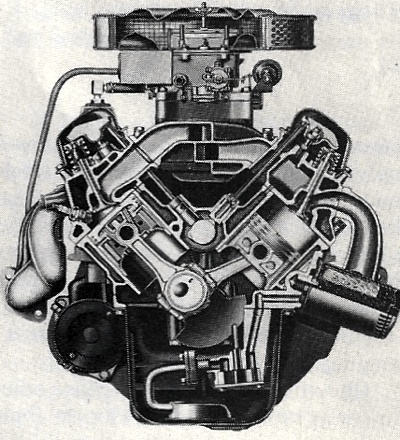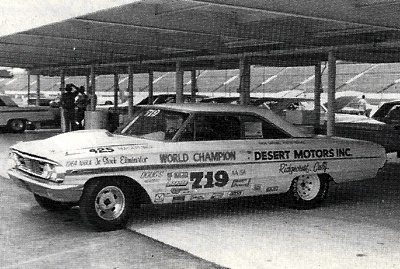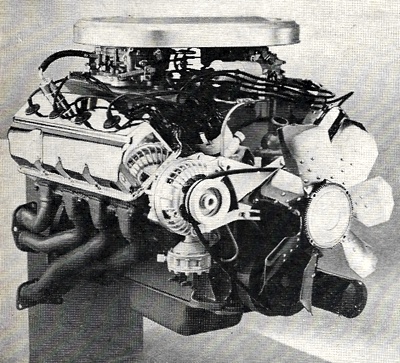|
American Muscle Cars of 1964
|
Country: |
 |
 Many believe the true US musclecar era began with Pontiac's 1964 GTO.
Many believe the true US musclecar era began with Pontiac's 1964 GTO. |
By
1964 the first wave of the post-World War 2 baby boomers had reached 17 and 18 years of age - ready for driving and, for men, the draft. For most, the draft meant Vietnam, only most didn't know it yet, because it wasn't front page news. The sudden increase in the teenage and young adult population meant drastic changes in the culture. And the swelling youth population also meant new profit opportunities for manufacturers of just about everything. For carmakers, this meant meeting demands for power, style and image.
Detroit was quick to respond. America's appetite for cars seemed unaffected by such things as a federal indictment against eight U. S. steel firms for price fixing, or a UAW strike against GM late in the year. No car enthusiast will need any reminding that 1964 was a turning point in the evolution of the high performance passenger car in America. That was the year, of course, when Pontiac introduced the GTO. And Oldsmobile seconded the motion just a few months later with a quick, throw-together copy called the 4-4-2. Big Chevrolet couldn't move quite so fast. But by the winter of '64 to '65 they managed to hand-build 200 Chevelles with a hi-po version of the new Mark IV big-block that they sold to selected VIP customers under a Z16 option code.
The Pontiac GTO
Those three cars started a vast merchandising move that brought race car performance to the man in the street – which made literally billions of dollars in profits for the Detroit carmakers. The era was stopped in the early 1970s by tightening safety and
exhaust emission standards, and by skyrocketing insurance rates for young drivers in these high performance cars. But for the eight years or so after early
1964, there was more performance action on American streets and highways than at any time before. It was another world. The definitive car from 1964 is the "GTO " - as contrasted from the big-block Super Stocks that were seen in the early 1960s. Essentially, the GTO was nothing more than an intermediate-size body with a big
engine.
The differences were that the early SS cars used full-size bodies, and their engines were basically detuned race engines. They were built in only limited numbers and were intended more for the drag strips and circle tracks than the street. The GTO was a fully equipped, practical everyday street machine. Its
engine was hopped up mildly with a special hydraulic camshaft, high compression and a good dual
exhaust system. But it was no detuned race
engine. The GTO's performance came from a combination of light weight, strong mid-range torque, optimum gearing and tuned heavy duty suspension and steering that gave better-than-average handling. Some of the magazine writers at the time called it a poor man's Ferrari, which is where the GTO designation came from: Gran Turismo Omologato.
The power race in Detroit was also going great guns, with new hardware appearing onrace tracks destined to find its way onto the streets. But actually, the market in new performance cars in 1964 was really very limited. Ford, for instance, was concentrating on the hi-riser 427
engine, which was really an out-and-out competition motor. The raised intake ports and the manifold required a high bubble in the hood to clear the carbs, and there wasn't sufficient forward visibility to make a safe street car. The company never offered the
engine in a viable street job. Its 1964 big-block offerings were a few Galaxies with early
1963 dual quad 427s. Chrysler, like Ford, was occupied with a new competition
engine in 1964: the famous 426 Hemi. This was not offered for the street that year either - only in lightweight drag cars and steel-body NASCAR cars. They did build a handful of 426 Max Wedge Dodges and Plymouths, but mostly to use up parts left over from the '62 to '63 race programs. The new
Hemi was all the rage in 1964. But Chrysler wasn't going "street" engineering.

The 1964 Ford Super Stocker. The hood bubble is necessary to clear the hi-riser manifold on the 427
 Ford's 271 hp 289 V8.
Ford's 271 hp 289 V8.
 The 1964 NHRA record-holding lightweight 427 Ford Galaxie.
The 1964 NHRA record-holding lightweight 427 Ford Galaxie.

The awesome 1964 Chrysler Hemi-Head V8.
|
The GM front office edict in early
1963 had put a stop to their racing programs. After that they built a limited number of dual quad 409s, but the steam was out of the program. Everybody was looking forward to a rumored "porcupine" head
engine scheduled for '65. In fact, Chevy sold more detuned 409s with hydraulic cams than all-out solid lifter jobs in 1964. So this left Pontiac's new GTO with just about an open field in early 1964. And that's the way it was. Street fans flocked to the Pontiac showrooms. Even some loyal Ford and Mopar followers were curious.
Pontine officials had only intended to build about 5,000 GTOs in 1904, as the car was really a maverick combination in the eyes of the GM front office. The top brass had decreed that big V8s should not be used in intermediate A-body cars, like the Chevelle and Tempest. The GTO was a sneaker that got past the "14th floor." But once the thing hit the streets, Pontiac couldn't keep up with demand. By March, GTOs were back-ordered several months, and final production hit 32,000 units the first year! When the GM brass started counting profits, all was forgiven.
Good news for street performance enthusiasts in '64 was the introduction of brand-new, heavy duty manual 4-speed transmissions by each of the Big Three to replace the delicate Warner T-10 that just couldn't be trusted in extended use in heavier cars. All these new designs—the GM Muncie, Ford Toploader and Chrysler A-833—were two or three times stronger than a T-10, as well as being easier and quicker to shift, easier to repair, quieter and really not that much heavier. The Chrysler A-833 was the heaviest, at 105 pounds. But they were all worlds better. It goes without saying that a large portion of the early GTOs were ordered with the new close-ratio Muncie 4-speed, not to mention optional Tri-Power carburetion and 3.91 Posi rear end.
They were bought strictly with street racing in mind. And they were definitely the cars to beat that year, unless you had one of the older Super Stocks in good shape (409 Chevy, etc.]. A well-tuned '64 389 GTO typically equipped as above could turn quarters in the mid-14s at 95 to 98 mph, running up to 5800 rpm or so in the gears with adjusted rocker studs. Seems like there were a million of the things on the favourite stoplight streets (like Detroit's Woodward Avenue and Southern California's Van Nuys Boulevard) back in those days. Pontiac definitely scooped the industry with the 1964 GTO.
The GTO imitators were quick to appear. Within six months after the GTO hit the streets, in the spring of 1964, Oldsmobile had a crude copy available — the new 4-4-2 option package for the F85 coupes. To get one, you checked off the B09 box on the order blank, which was the F85 Police Apprehender package - and Olds added a few emblems and special trim to give you your GTO-fighter. The B09 package cost only $285 extra. It included heavy duty suspension (including a rear
anti-roll bar), wide wheel rims and dual
exhaust, plus the Olds small-block 3 30-cubic-inch
engine was hopped up with a special high-lift cam, high compression, 4-barrel carb and a big dual-snorkel air cleaner. It was rated at 310 gross hp at 5200 rpm. The wide-ratio Muncie 4-speed was a mandatory option.
That first 330-cube 4-4-2 was a pretty decent performer, considering the displacement. It could turn quarters in the mid-15s at 88 to 90 mph. No match for a good GTO Tri-Power, but not bad for a quick and dirty answer to a new market segment that was exploding. It got the 4-4-2 name established, anyway. Some Mopar fans don't realize that Chrysler put out a pretty healthy street
engine option for Dodges and Plymouths in 1964.
This was the new 426-S engine - the S was for Sport option. It was essentially a standard 426 4-barrel
engine, but with a hot 268-degree camshaft, a low-restriction air cleaner and a dual
exhaust system. Gross rating was 365 hp at 4800 rpm. When run in a light Dodge or Plymouth coupe with 3.54 or 3.90 gears, you could easily turn quarters in the low 15s at 90 mph. This could stay pretty close to a standard 4-barrel GTO, but not a Tri-Power.
The GTO owed its success not just to its performance, but also to its appeal as an image machine. The same has been true of many performance cars ever since—they get driven out of the showroom simply because their buyers want to say, "Hey, look at me!" with a big four-wheeled toy. Which brings us to the all-new Mustang sport coupe that Ford unveiled in the spring of 1964. It truly kicked off the big "Look at me" market segment. It's well-known now how the Mustang caught on big and made millions in profits for Ford even that first year. As far as brute performance was concerned, though, the Mustang wasn't really in the chase, simply because the chassis was too small and light to house a big-block V8
engine. That was a crippling disadvantage among the stoplight crowd, and it wasn't corrected until the first major redesign in
1967.
But it hardly mattered. The car had universal appeal, for both men and women. By building a car that had the look of a two-seater with the practicality of four seats, Ford had one of the biggest winners in automotive history. A light, nimble '64 Mustang with Ford's optional 289-cubic-inch small-block high performance V8 was one of the sweetest street fun packages you could buy that year. The car itself weighed only 3000 pounds at the curb. Sure, the
engine was small, but its extreme light weight of only 460 pounds contributed to the nice balance of the Mustang. And since you automatically got heavy duty
suspension and
brakes when you ordered the HP 289
engine, the handling was outstanding.
The
engine was no slouch, either. The HP package included a bigger 4-barrel carb, 11.6:1 compression, 306-degree solid-lifter cam and beefed-up bottom end, plus spe-^ cial streamlined
exhaust manifolds to dual mufflers. The gross rating of 271 hp at 6000 rpm was only a hint of things to come. Out on the street, the HP 289
engine would rev happily to 6500 rpm, and even to 7000 on a missed shift without breaking. With Ford's Toploader 4-speed and optional 3.89 gears, the net power could get a quarter in maybe mid-to high 15s at 85 mph. No threat to the big-block musclecars, but fun, fun, fun. These Hi-Po 289 Mustangs were quite popular with the fringe street crowd in 1964. So there you have the best of the 1964 performance crop. If we had to list them in the order of their performance potential, they might go something like this:
- Pontiac GTO Tri-Power
- Pontiac GTO Standard 4-barrel
- Dodge/Plymouth 426-S
- Oldsmobile 4-4-2 5. Ford Mustang HP 289
But you still had to watch out for the older Chevy 409s, Ford 406s and 427s, and Max Wedge Mopars. And by the mid 1960s, there were a lot of modified 1956 and 1957 Chevys on the streets. They could embarrass a new GTO real bad.
Chryslers 1964 Hemi Head V8s
Chrysler’s 1964 performance engines turned out to be even more legendary than the old Firepowers built from
1951 to
1957. In their day, the Firepower V-8s could churn out more horsepower from a given
engine size than any
engine previously offered. Even into the mid 1960s resurrected versions of this
engine were supplying the push for some of the fastest dragsters in the USA. The secret of this success lay in the head design, with its wide-open ports, laterally inclined
valves, and hemispherical combustion chambers.
The
hemispherical head has been around almost as long as the
internal combustion engine. Before the mass-produced, pushrod-operated Chrysler unit, it was a design usually found only on high-priced imports and all-out racing cars. The design offered many distinct advantages - plus some disadvantages. The disadvantages were all of a production and cost nature, and Chrysler originally abandoned the design because its lukewarm acceptance by the public didn't justify its added cost. From a performance standpoint, the advantages far outweighed the disadvantages. Since an
engine runs on an air/fuel mixture, its output naturally depends on how much mixture it can take in and how effectively the mixture can be burned. The hemispherical design permits larger
valves and larger, straighter ports than any other design. This means unequalled breathing capabilities. The combustion chamber shape allows the best spark plug location and is also less prone to detonation and pre-ignition.
For
1964 Chrysler offered three new versions. Two were for drag racing, and the only difference between them was that one had 11 -to-1 compression, while the other had 12.5 to 1. Both drag racing engines featured dual four-barrel carburettors mounted on ram intake manifolds. The third
engine was for circuit racing and had a 12.5-to-1 compression ratio and a single four-barrel carburettor. All three engines had tuned
exhaust systems. Displacement remained the same at 426 cubes. Bore and stroke of the then new engines were identical to the present "426," but none of the major parts were interchangeable. The rods were beefier and the main bearing caps were now cross-bolted for increased strength.
The way manufacturers rated the output of their performance engines was always shrouded in mystery. In the 1950s they always tagged them with rather optimistic figures - it was doubtful that actual outputs ever approached ratings. But by
1964 they were rating them very light – probably to help keep insurance premiums down. For example, 1963’s "426" engines, the drag race versions, were rated at 415 hp for the 11-to-1 compression ratio and 425 hp for the 12-to-1. The
1964 engines carried identical ratings, but they were both putting out at least a full 125 hp more. The circuit
engine was rated at 400 hp, but according to back-door reports at the time, 525 hp would be more realistic. Both Plymouth and Dodge offered these new engines. The Dodge version was known as the Hemi-Charger 426, while Plymouth's carried the Super-Commando designation.



